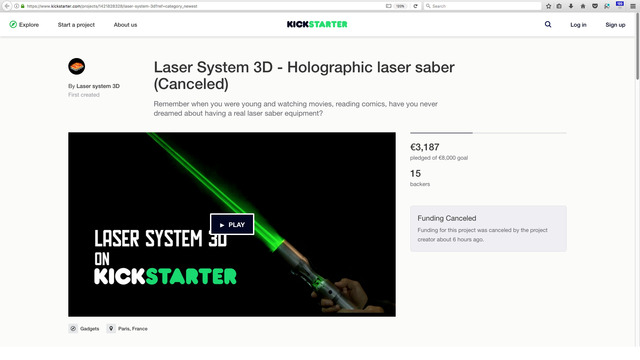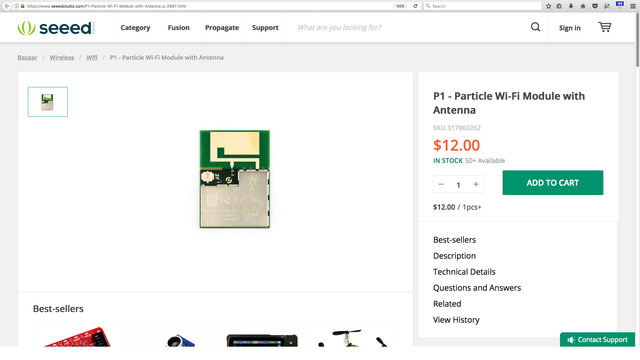Weekly Roundup #46 - New Maker Products // News
Seems there’s a new Information Technology video out! Wonder if it’ll be funny? Speaking of Information Technology, Weekly Roundup #46 is here with a couple of new SBCs, interesting gossip and a bit of clowning around.
Crowd Funding
KickStarter
xaVNA
First up on KickStarter is the xaVNA. This is a Vector Network Analyzer, which are normally fairly expensive, but this one is for around US$200, almost halving the price of the PocketVNA. Has a frequency range of 140MHz to 3.5GHz, with some decent dynamic ranges for the price. Runs off a 500mA/5V supply with Windows Linux and Mac O/S supported.Laser System 3D
OK, not really a Maker Product, but thought this was cool. It’s essentially a real life light sabre, without the issue of cutting your fingers off. Not sure how it works, but looks like they are pushing out steam or smoke out of the end so the laser can reflect. Alas this campaign was cancelled before I published, so you’ll just get to see it here.NOVA
Now, this is something to keep you awake at night. It’s a DIY kit with a 4 axis servo frame allowing you to create a reactive robot face. Can track movement and stare at you ominously from the other side of the room.Gamebuino META
The original Gamebuino was launched 3 years ago. Well, now they’re back with an updated version. This one runs the SAMD21 Cortex-M0+, with a 80 by 64 pixel RGB display, 900mAh LiPo, multi-channel sound playback and SD card. They have made available all the GPIOs from the SAMD21 and have open-sourced everything. Nice.24pin BASIC controller
This is a simple Kickstarter with not much info, but claims to be a super-set of the Parallax BASIC stamp. No idea what the MCU is, but they mention it’s an ARM based one. If Bruce is reading this page, then I suggest adding a lot more detail on this campaign. That would attract a lot more people.IndieGoGo
Atom X1
Seems that the latest war in the electronics Maker market is making things as small as possible.IndieGoGo has a campaign for the Atom X1, which they claim is the world’s smallest Arduino board. Back in Weekly Roundup #31 there was the uDuino which came in at 12mm squared. Alas this one is almost 15mm squared. So, the claim is still with uDuino. Sorry guys! However, it is the first smallest SAMD21 based board out there and due to the size only pushes out 9 of the 26 GPIOs the SAMD21 is capable of.
Crowd Supply
BeagleWire
Over at CrowdSupply there is yet another Michael Welling product in pre-launch called the BeagleWire. It’s a BeagleBone cape with on-board Lattice iCE40HX FPGA, 32MB RAM and 4 PMOD & 4 Grove ports. All schematics and software are fully open, which is nice to see, and there’s a comprehensive wiki on it over at elinux.org.GroupGets
PUREmodules Kit
Over at GroupGets they have the PUREmodules Kit which has been around for a while now. This is an nRF52 based board with 3DOF IMU and temperature sensors. Runs off a coin cell battery and can be OTA programmed via the Arduino IDE. It also supports Wirepas and HomeKit. Nice to see.Hamamatsu C12666MA Breakout
This C12666MA breakout board is currently on sale at the moment, which is a MEMS spectrometer. Good for if you’re in to fluorescence spectroscopy as that sort of test gear normally ends up costing a bucket load. Note, however, that this MEMS sensor is actually a product End Of Life.$1 ESP-32S
And if you’re looking for a cheap ESP-32S, then GroupGets has them for $1 each. What’s the catch? You can only buy one at a time and shipping costs a lot. So for me it’s pointless as it’d cost 5x than getting it elsewhere.Honorable mentions
Hack-A-Day Anything Goes competition
The HackADay “Anything Goes” competition has finished with twenty winners announced.Like the BeagleLogic Standalone which can sample 16 channels at 100Msps. Fully compatible with sigrok and can stream over 1GbE.
Or a $4, 4 IC Z80 computer.
Or the MappyDot, with ATmega328PB, VL53LOX sensor in a tiny package. You interface to it over I2C and an auto-addressing scheme allows you to connect up to 112 devices.
Or an 8bit color computer built from discrete logic ICs. He’s even implemented a few 2 instructions per clock, instructions.
Hack-A-Day superconference
If you’re in Pasadena on the 11th and 12th of November then you have to head over to the Hackaday Superconference. Two days of nerd talks. Nice. You can also pick up a really hackable SuperCon badge. Wonder if the burn marks will be present on all the badges?AdaFruit trademarks
Back in Weekly Roundup #45 we saw a bit of noise about AdaFruit and RadioShack. The word on the street is that it was just a bit of noise. However, they have just recently filed a trademark claim for the word “RadioFruit” and they already have products called that on their website.Banana Pi M2 Magic
One of the fruit shop guys have come out with a new SBC. We now have the Banana Pi M2 Magic. For US$23 you can get a quad core Cortex-A7 AllWinner A33 based board with 512M DDR3 RAM, optional 8 or 64G eMMC, SD slot, WiFi, Bluetooth using the AP6212, (what else), MIPI-CSI & DSI all on a 51mm square PCB. This places it in direct competition with such boards as the Orange Pi R1 and NanoPi Neo Plus. Good to see some different product names appearing.Gumstix Cobalt MC
The Cobalt MC is pretty expensive, but it’s a board aimed at multimedia. It runs the 1GHz quad-core Cortex-A9 NXP iMX6 with 1G DDR2 RAM, SD slot, GbE, WiFi, Bluetooth using the WiLink8 module. It has a decent graphics engine on board that can handle a two 4 lane MIPI-CSI ports.Olimex SOM204 format
Olimex is back, this time with a new form factor board called the “SOM204”. This board is based on the AllWinner A20 with 1G RAM, 64G eMMC and GbE. Their ultimate goal is to create SOM204 modules for the AllWinner A13, AM3352 and RK3188 SoCs.SixFab’s 3G/4G/LTE Pi hat
SixFab has a 4G/LTE hat for the Pi based on the Quectel EC25-E which plugs in via a mini PCIe socket. You can order one of these for a little over US$30. Even if you’re not interested in the Quectel module, which you have to purchase separately, this board might be a cheap way of adding a mini PCIe interface to the Pi.PingPong IoT boards
Fairly expensive, but they get the job done. If you’re in to some serious IoT, then one of these will give you a PIC32MZ running RTOS or Linux, 4G module, GNSS, 100MbE, WiFi, Bluetooth and an expansion header for NFC, RFID, Sigfox, LoRa and Iridium. This board is pretty serious stuff for serious developers.Telegea Smart Hub
DEK Italia have released DIN Rail format IoT gateway with a Raspberry Pi CM3 socket. It breaks out most of the goodies from the PI3 but also has an XBee expansion header, RTC and SHT21 sensor. Can be powered from USB or 24Vdc supply.Gumstix Pi Conduit PoE
Another Gumstix, this one providing PoE over GbE to a Pi CM3 socket. It also has a socket for the RHF0M301 LoRa module.UniElec opensource router
UniElec have released a so-called open-source router. Well, essentially every router is open-source even if the original manufacturer didn’t intend it to be. This board runs OpenWrt on an MT7621 with up to 512M DDR3 RAM, SD slot, SATA 3.0, miniPCIe for mSATA and an additional two miniPCIe for WiFi modules and 5 GbE ports. You can currently pick them up on AliExpress for around US$40.DragonWally
If I say the word “DragonWally” then you’d really have no idea what it is. Well, it’s a board that makes it easier for you to implement stereoscopic vision. It’s a 96boards compliant PCB that’s designed to fit on to a DragonBoard and has two 5MP cameras accessible over MIPI-DSI. Supports OpenCV out of the box as well as the AWS Rekognition API for facial recognition.OpenBSD for the Orange Pi PC2
The latest release of OpenBSD adds support for two new ARM cores, which are the AllWinner A64, AllWinner H5, BCM2837 and RK3399 SoC. So, you’ll now be able to run OpenBSD on a couple of Orange Pi SBCs, Pine 64, Firefly-RK3399, NanoPi Neo2 and PI 3. This means that possibly a scaled down version of FreeNAS will be heading our way soon. Nice.Maker Shops
Tindie
Lots of things over at Tindie this week.
Freematics ESP32
The Freematics ESP32 board comes in an Arduino form factor, but has an Xbee socket that you can stick a 3G SIM5360 module and another to allow you to connect one of their OBD ports.7-port NanoHub
A 7 port USB hub in a tiny package! This comes from the same Tindie store that has the 4 and 2 port hubs.EasyPads
This is a good idea which allows you to quickly hack together a circuit without a breadboard.EMP sensor
This is a pretty cool board that will sense EMP caused by lightning. You can theoretically use it as a camera trigger so you can get some cool photos.Micro Launchpad
The MSP430 MCUs are fairly versatile based on a RISC core, and a fairly similar lineup to the STM32 and ATSAMs. This store has a couple of breakouts based on them.Arduino Nano with Grbl CoreXY
CNC machines come in several styles. One style is to use 2 motors on a single belt to control the X and Y axis. It’s a cool idea and the best way to control them is using the Grbl CoreXY firmware running. This store has this firmware preloaded on an Arduino Zero for you.PRUDAQ
Oh look! The Prudaq from Weekly Roundup #45 is on Tindie now!FTDI Hack
The FTDI Hack is a breakout board for the FT231XQ IC, which is similar to SparkFun’s version, but cheaper.DIY DSO
There’s quite a few DSOs around. Here’s one you can build yourself based on a 50MHz PIC32. Has all the usual good stuff like; 1MHz single channel Oscilloscope, 4 channel logic analyzer, signal generator and frequency counter.TrackIMU
Oh look! The TrackIMU in last week’s roundup is on Tindie as well.AdaFruit, Seeed, SparkFun, DFRobot, DigiKey
Particle Wi-Fi Module
Over at Seeed Studio they have the Particle P1 WiFi module running the BCM43362 IC and an STM32F205 with 1MB flash, external 1MB SPI flash and 25 GPIOs. This one has a break-away antenna or there’s the smaller Particle P0 module.Raspberry Pi Dual band Radio hotspot
This looks pretty cool. It’s a DVMEGA Pi hat with on-board VHF and UHF radios. Power output is 10mW, so not huge but enough to transmit over the DMR+ network.BlueStack Micro+
The BlueStack Micro+ is another DVMEGA board that supports DMR over Bluetooth or DSTAR, Fusion and DMR over USB. This one is designed specifically for the IoS platform, and this one for the Android platform.INA219 FeatherWing
Over at AdaFruit they have a FeatherWing with on-board INA219 IC, which is a power monitor allowing you to measure up to 3.2A and 26V DC. You can change the current sense resistor to a lower value to increase the max amperage to 32A.Spectral Sensor Breakout
Over at SparkFun they have a spectral sensor. No, not a spectre sensor. It’s not Halloween yet! It’s a spectrometer that will detect wavelengths from 450 to 650nm in the visible spectrum. Accessible over I2C and UART.They also have one that extends that range from 610 to 860nm.
FireBeetle ATmega328P
Over at DFRobot there’s the 328P FireBeetle with on-board Bluetooth 4.1 module. It supports all the usual FireBeetle add-ons and can draw only 70uA while in sleep mode.qualMeter
Back in Weekly Roundup #34 we saw the qualMeter on Kickstarter. Well now DFRobot are selling all three models; the Advanced, Mini and Basic.64x64 RGB LED Matrix Panel
And LED panels are getting cheaper and cheaper. Unfortunately I missed out on the used 64 by 64 panels on eBay at a ridiculous price, but DFRobot have them still.TPSM842xx Power Modules
Over at DigiKey they have some tiny power modules based on the TPSM842 giving you 3.3, 5 or 12v out from a 24v input. Pretty handy.InvenSense DK-20948 development kit
It’s hard to think of a company such as TDK creating motion sensor development boards, but here’s one on DigiKey. This one runs an Atmel SAMG55 MCU and ICM-20948 9DOF IMU.The Cheap Side
And over in China we have …
MPL3115A2 I2C Pressure/Temperaure sensor
A breakout for the fairly accurate MPL31115A2, (can’t find any links to this! Leave a comment below if you find one.), temperature and pressure sensor. Runs off 3.5 to 5v and can drop down to 2uA in standby. Even at a 1Hz sampling rate it only consumes around 9uA.MP3 decoder board
And for only US$1.38 a pop you can get an MP3 player with amplifier and SD slot. Man, you’d never be able to make one of these cheaper.INA3221 I2C current/power monitor
And here’s a 3 channel low and high side current and voltage monitor running the INA3221 IC, which is accessible over I2C.GPRS/EDGE / LBS positioning board
Apparently you can pick up a tiny GSM module for only US$8! This one runs the MTK6260M, (another link I can’t find! Let me know if you find it.), GSM module and if you’re lucky to be in a country with a running GSM network still you’ll be able to use it.ESP-M3
Back in Weekly Roundup #42 there was the ESP8285 on Seeed Studio. Now BangGood have the ESP-M3 which isn’t quite as small as the Seeed version, but close.STC15F104W microboard
Remember the old 8051 CPUs? Well here’s a new take on an old CPU. This breakout has an updated 8051 CPU, (STC15F104W), that will run code 20% faster than the previous incarnation of this chip, (STC15F104E), along with 6 GPIOs.Waveshare 7.5'' 640x384 e-ink display
Over at DX they have a couple of e-ink displays. This one is a 7.5" three colour 640x384 pixel display…Waveshare 2.13'' 212x104 e-ink display
and this one is a smaller 2.13" display at 212x104 resolution.Honorable mentions
A few bits and pieces that I didn’t include in my video.
































































